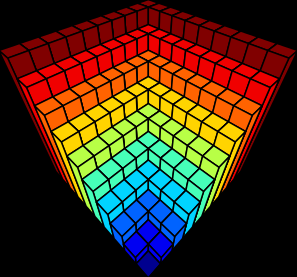
Identity
The sequence A181983(n) gives the determinants of the square matrices:
This identity appears as follows:
Proof
A new matrix with the same determinant can be created by subtracting row
This can be better illustrated with an example:
We can transform:
Into:
This proof can be generalized to a very similar type of matrices, resulting in:
References
[1]
N. J. A. Sloane, “A051125: Table t(n,k) = maxn,k read by antidiagonals (n >= 1, k >= 1).” Available: https://oeis.org/A051125/
[2]
M. Somos, “A181983: A(n) = (-1)^(n+1) * n.” 2012. Available: https://oeis.org/A181983/
[3]
E. Deutsch, “A161124: Number of inversions in all fixed-point-free involutions of 1,2,...,2n.” Jun. 2009. Available: https://oeis.org/A161124/
[4]
N. J. A. Sloane, “A001147: Double factorial of odd numbers: A(n) = (2*n-1)!! = 1*3*5*...*(2*n-1).” Available: https://oeis.org/A001147/